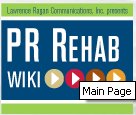
Ranked in order of search engine popularity
ToolURL identifies t
he most searched for keywords including their search count. it is used for Search engine optimisation. A practice all PR people should be aware of.
I thought I should try 'Public Relations' in a blog post. I can then compare it to WordTracker on the My Internet Lectures Blog.
Next experiment is to put the same words in the same order in tags. Not today though - of course I'm playing!
10791 public relations
4309 public relations agency
327 public relations consultant
276 public relations agency uk
236 london public relations
220 public relations uk
203 public relations firm
174 public relations photographer
144 public relations jobs in london
141 public relations consultancy
131 institute of public relations
110 consultant london public relations
106 public relations manchester
98 public relations jobs
93 public relations company uk
92 public relations kent
91 public relations services
82 effective public relations
77 crm public relations
74 public relations course
70 public relations specialist
69 public relations east sussex
63 north west public relations
60 public relations company
59 public relations definition
59 engineering public relations technical
56 brighton consultant public relations
53 public relations doncaster
49 handbook public relations
49 public relations south yorkshire
48 care health public relations
45 financial public relations
44 spotlight public relations
43 agency asian public relations
43 chartered institute public relations
41 company limited public relations
40 marketing and public relations
39 public relations strategy
37 public relations plan
35 public relations degree
34 effective public relations skill writing
34 fashion public relations
34 public relations tarantino
33 communication marketing public relations role sme
32 `internal public relations`
31 career in public relations
31 communication designing public questionnaire relations survey
30 agency colchester public relations
30 agency media public relations
30 consultant doncaster public relations
30 freelance in job public relations
30 ophthalmologists public relations
29 public relations job description
29 hair product public relations
28 pr public relations
27 gym public relations
27 physician public relations
27 plastic public relations surgeon
26 celebrity public relations
26 public relations fitness
25 firm public relations state united
25 public relations glasgow
25 public relations major
25 public relations recruitment
24 beauty product public relations
24 public relations book
24 exploring public relations
24 media public relations
24 public relations writing
23 public relations spa
22 care public relations skin
22 dermatologists public relations
22 dummy public relations
22 public relations salon
21 public relations association
21 beauty public relations
21 business course media public relations
21 cosmetic public relations
21 government local public relations
21 international public relations
21 public relations theory
20 brunswick public relations
20 public relations career
20 jobs in public relations
20 international ltd public relations
20 kelly public relations teri
19 the business public relations
19 competency framework public relations
19 public relations consultancy uk
19 consultant manchester public relations
19 public relations music
19 national public relations
18 public relations campaign
18 cheltenham public relations
18 creativity in public relations
18 framework public relations skill
18 studying public relations
17 corporate financial public relations
17 public relations education
17 public relations officer
Picture:
A New Tool Kit
 Swindon, the home of Billie Piper, Melinda Messenger, and yours truly has the highest number of homes in the UK with a broadband connection, research revealed today.
Swindon, the home of Billie Piper, Melinda Messenger, and yours truly has the highest number of homes in the UK with a broadband connection, research revealed today.














